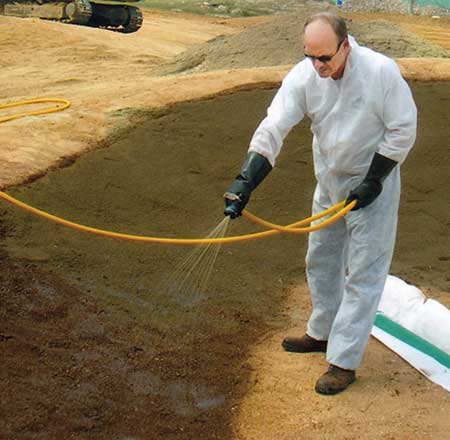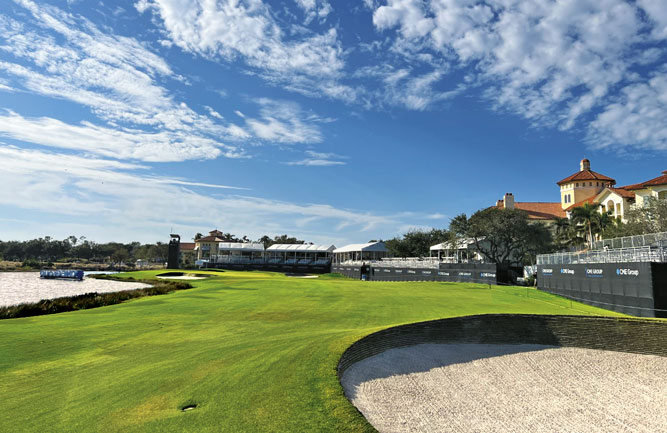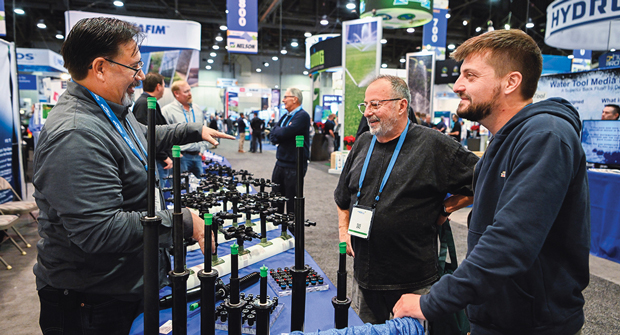Going bunkers: 4 courses with bunker success stories
Spray away
How Presidio GC in San Francisco undertook a bunker renovation piece by piece
By Sarah Webb | Golfdom Managing Editor
About 10 years ago, Presidio GC in San Francisco underwent a rehabilitation
project, in part, because its 64 bunkers were in dire need of a facelift.

Klingstone bunker liner can be applied in-house using a hose. (Photo: Klingstone)
“They were old, some of the fabric liners were coming up and a lot of them didn’t have liners, so the sand was contaminated and became like concrete,” says Brian Nettz, who has been superintendent at Presidio Golf Course for the past 18 years. “The rehabilitation included changing the location, shape and size of the bunkers to give the course a different feel.”
After researching the options, Nettz settled on Klingstone. The reasoning was fourfold: In-house staff could install the bunkers; heavy equipment was not required; the installation could be done incrementally over the course of several years; and maintenance over time is minimal due to the lack of liners.
“Everything just pointed toward Klingstone,” Nettz says.
Little by little proved to be the tactic for Presidio, as the bunker renovation took place over the span of eight years.
“We didn’t want to devote a huge chunk of money to tearing everything up at once because there’s a corresponding revenue drop that we didn’t want to bear,” Nettz says. “We do 66,000 rounds a year, so the hit on our bottom line would’ve been significant.”
To install the bunkers, crews rough graded them to get the desired shape and undulation. They then cut the drainage inside the bunkers and tied it to the outlets. After the soil dried, they sprayed on the Klingstone.
“We put a couple barrels of Klingstone in the back of a utility cart, and our guy wore a Tyvek suit and some boots and basically spray painted the inside of the bunker with the Klingstone,” Nettz says.
After setting for about an hour, the product hardened up, and crews put the drainage in. Nettz says Presidio also sprayed the drains in order to achieve a complete seal throughout the bunker.
Presidio used Turf Drain, a flat all-fabric pipe, and then backfilled the entire bunker with sand the next day. “There’s no gravel to worry about in any of the bunkers,” Nettz adds. Klingstone fully cures within 24 hours or less, according to John Ammons, vice president for Klingstone.
“You put down a gallon a minute, which is 20 square feet of coverage, so you can move along at a good clip,” Ammons says. “Immediately after finishing, you can cover it with sand and move along. By that time the next day, it’s fully cured and playable.”
For other courses looking into installing Klingstone bunkers, Nettz recommends crews keep two pumps on hand.
“You may be in the middle of spraying a bunker when one of the pumps goes out on you,” Nettz says. “You can’t stop Klingstone from curing; it’s kind of like pouring concrete — once you start, you have to see it through to the very end.”
Ammons adds that weather can be another factor to consider when using Klingstone’s product. “It can’t be applied to frozen ground. The temperature should be 50 degrees and rising,” Ammons says. “High winds can also be a challenge because you’re spraying it.”
The oldest Klingstone bunkers on Presidio are 10 to 11 years old, and maintenance is minimal to nonexistent, Nettz says.
What’s more, Nettz says, the golfers love the challenge the new bunkers pose.
“We have fine fescue on our fingers that we don’t maintain, but the look is a lot more fitting for the era this golf course was originally built (1895), and it’s less maintenance for us because we don’t have to worry about mowing bunker fingers.”












